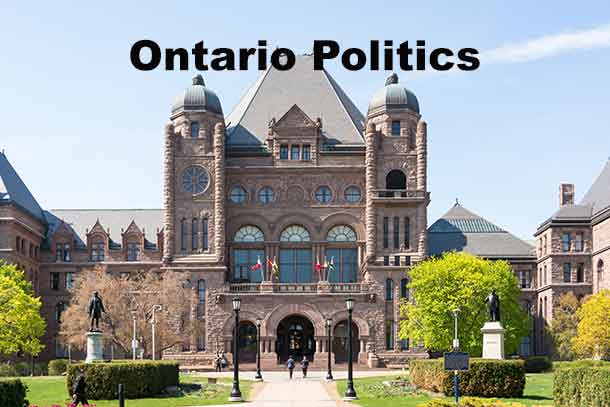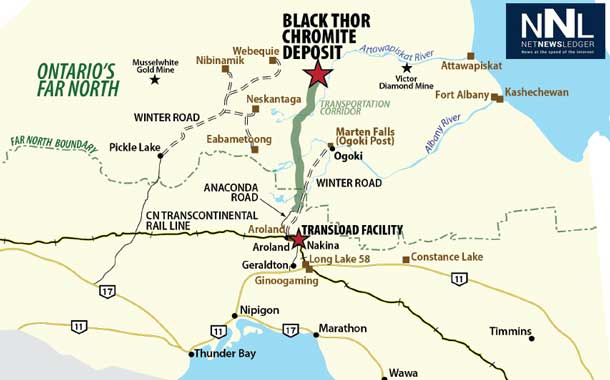
TORONTO – Ontario is dipping into a reserve fund in order to keep the province’s finances on track.
Today Ontario Finance Minister Charles Sousa presented the 2014 Ontario Economic Outlook and Fiscal Review, which the Minister states “Confirms that the Province is working to eliminate the deficit by 2017-18. The government continues to project deficits of $12.5 billion in 2014-15, $8.9 billion in 2015-16 and $5.3 billion in 2016-17, with a return to balance in 2017-18, consistent with the plan outlined in the 2014 Budget. This will improve the fiscal sustainability of the Province and help protect the critical public services that support the well-being of Ontarians”.
The news is not all rosy however, the Minister is projecting that Ontario will take in $508-million less revenue than was projected for the 2014-15 fiscal year.
The projection means that there will be $300 million that will be pulled out of reserves in order for Ontario to maintain the programs that province has planned. In a statement, Minister Sousa says, “Although the global economic environment remains challenging, there are signs that Ontario’s economic expansion is gaining some momentum in 2014, following weak growth in 2013. The unemployment rate in Ontario declined to 6.5 per cent in October 2014, the lowest rate since 2008.
“Even though the current revenue outlook is lower than projected in the 2014 Budget, the government is working to meet its fiscal targets”.
As part of the Wynne Government’s plan to help grow the economy, strengthen revenue integrity and create jobs, the Minister says that Ontario will continue to invest in people’s skills and talents; build modern infrastructure and transportation networks; create a supportive and dynamic business climate; and strengthen retirement income security for all Ontarians. Highlights of the four-point economic plan include:
Investing in Ontarians’ Talent and Skills
One of Ontario’s greatest strengths is its people’s talents and skills. Highlights of the government’s investments in people include:
- Completing the rollout of full-day kindergarten and investing in child care modernization so that every child has the best start in life.
- Awarding more than 2,200 Parents Reaching Out Grants during the 2014-15 school year to help school councils identify local barriers to parent engagement and find solutions to get more parents involved in their children’s education at home and school, particularly in math.
- Launching Experience Ontario, a nine-month paid community work and service program that allows high school graduates to gain valuable work experience before they enrol in postsecondary education or choose their career path. This program will roll out in 2015.
- Providing the 30% Off Ontario Tuition grant, which helped over 230,000 students start college or university last year.
- Extending the Ontario Youth Jobs Strategy, giving more young people the chance to gain a foothold in the job market. This strategy is on track to create 30,000 job opportunities, including more than 23,000 placements to date under the Youth Employment Fund.
Building Modern Infrastructure and Transportation Networks
Ontario must build and maintain infrastructure to remain economically strong and competitive. That is why Ontario is planning to invest more than $130 billion in public infrastructure over the next 10 years, including $12.8 billion in 2014-15. These investments will focus on transportation, health care and education, and are expected to support over 110,000 jobs on average each year. This commitment builds on nearly $100 billion in infrastructure investments by the Province since 2003, which have helped make Ontario safer, more competitive and more productive.
Highlights of the plan include:
- Making nearly $29 billion in dedicated funding available over the next 10 years for public transit, highways and other priority infrastructure projects across the province through the government’s Moving Ontario Forward plan. Moving Ontario Forward will allocate up to $15 billion for the Greater Toronto and Hamilton Area in public transit priorities that address congestion and improve mobility throughout the region, including transforming the GO Transit network to a Regional Express Rail service, and nearly $14 billion for projects elsewhere in Ontario that enhance economic growth and address critical infrastructure needs.
- Building better places to learn, with plans to provide funding of more than $11 billion over the next 10 years for elementary and secondary education infrastructure.
- Increasing access to postsecondary institutions, by continuing to expand the Province’s postsecondary education infrastructure in areas where student demand is strong and where there are gaps in access.
- Investing in modern health facilities, with plans to invest over $11.4 billion in hospital capital grants over the next 10 years to provide adequate infrastructure capacity in the health care sector. Across Ontario, more than 40 major hospital projects are under construction or in various stages of planning.
Creating a Supportive and Dynamic Business Climate
Ontario continues to focus on creating a dynamic and innovative business climate while improving productivity. To this end, Ontario has significantly improved its tax competitiveness, making the province a more attractive location for business investment.
Ontario’s general Corporate Income Tax (CIT) rate has been reduced from 14 per cent to 11.5 per cent, resulting in a combined federal-Ontario general CIT rate of 26.5 per cent. This combined rate is lower than the combined federal-state CIT rate in any of the U.S. states and lower than the average CIT rate of G8 and G20 member countries.
Highlights of the government’s recent initiatives include:
- Focusing on supporting strategic private-sector investments in innovation, productivity and export opportunities through the government’s 10-year, $2.5 billion Jobs and Prosperity Fund. All business projects supported by the Jobs and Prosperity Fund will undergo a rigorous assessment to ensure substantial economic benefits, cost-effectiveness for government and a return on investment for Ontarians.
- Working to create a regulatory business environment that will help business to grow by introducing the Better Business Climate Act, 2014. If passed, it would ensure that regulatory burdens are being further reduced and smarter regulatory practices are being adopted. Doing so will help stakeholders save millions of hours in time and $100 million in costs by 2016-17.
- Continuing to implement Ontario’s Going Global Trade Strategy to help grow exports of Ontario’s high-quality goods and services as the global economy expands. The Premier of Ontario and 60 Ontario businesses and organizations recently returned from a successful trade mission to China. The trade mission has already attracted nearly $1 billion to Ontario in new deals, creating more than 1,800 jobs. The government signed 26 agreements during this week-long mission.
- Modernizing and strengthening Ontario’s financial services sector, including working with other jurisdictions, domestic and global, on new initiatives such as a trading hub in the Chinese currency in Canada, through collaborating with the Chinese, federal and British Columbia governments.
Strengthening Retirement Income Security for all Ontarians
The government is committed to a strong and secure retirement income system to help ensure that Ontarians are better able to enjoy their retirement years. Several studies have shown that, unless action is taken, a significant portion of today’s workers will face a decline in their living standard in retirement.
The government is continuing with its strategy to strengthen and modernize the retirement income system. Highlights include:
- Moving forward with the government’s plan to introduce a new mandatory provincial pension plan — the Ontario Retirement Pension Plan (ORPP) — that would offer a secure benefit for life. The implementation of the ORPP is intended to coincide with the expected reductions in Employment Insurance premiums in 2017. The government will introduce legislation shortly to begin the process of fulfilling its commitment to introduce the ORPP and will formally consult on key plan design issues in early 2015.
- Introducing a legislative framework for pooled registered pension plans (PRPPs) that is broadly consistent with the model introduced by the federal government and adopted by various provinces. PRPPs would offer employees and the self-employed a voluntary, low-cost, tax-assisted option to increase retirement savings. The government will introduce this legislation shortly.
- Allowing for more flexible models such as target benefit pension plans, which offer employers an innovative new option by combining features of defined benefit pension plans and defined contribution pension plans. The government will be consulting on a regulatory framework for target benefit pension plans in Ontario. Initial consultations, including the release of a consultation paper, will focus on a framework for target benefit multi-employer pension plans.
- Facilitating conversions or mergers of employer-sponsored, single-employer pension plans into new or existing jointly sponsored pension plans. The government intends to post regulatory proposals on the Regulatory Registry in the coming months. The regulations are anticipated to take effect on July 1, 2015.
Managing Spending and Making Every Dollar Count
The government will continue to build Ontario up by creating opportunity and security for all Ontarians. The government’s priorities and its determined effort to make every dollar count will help support eliminating the deficit in the near term and improve the fiscal sustainability of the province in the long term.
Balancing the budget by 2017-18 requires a thoughtful approach to making tough choices. Steps towards delivering on the government’s plan to balance are centred on:
- Program Review, Renewal and Transformation
- Managing compensation costs
- Ensuring everyone pays their fair share of taxes
- Unlocking the value of provincial assets.
Program Review, Renewal and Transformation
The Honourable Deb Matthews, President of the Treasury Board, is leading the Program Review, Renewal and Transformation planning process. It is designed around key principles, including looking at how every dollar across government is spent; using evidence to inform better choices and improve outcomes; working across government to best deliver services; and taking a multi-year approach to identifying program transformation opportunities and achieving savings.
Program Review, Renewal and Transformation opportunities will be identified to improve services and outcomes based on measurable results, to ensure that sustained funding goes to initiatives that work. At the same time, the government will also have to make tough choices about services that are not performing, do not link to government priorities, or no longer serve a clear public interest.
Managing Compensation Costs
The government is taking a consistent, fair and principle-based approach to manage compensation costs in the Ontario Public Service and across the broader public sector, while ensuring that service levels meet public needs. Broader public sector partners need to come together to manage compensation costs and control spending while protecting public services that Ontarians rely on and working towards balancing Ontario’s budget. Any modest wage increases that are negotiated must be absorbed within Ontario’s existing fiscal plan.
Ensuring Everyone Pays their Fair Share of Taxes
The government is taking concrete steps to strengthen revenue integrity and in 2013-14, its efforts generated over $380 million in additional revenue.
Building on this progress, Ontario will continue to ensure an effective tax administration system that addresses the underground economy, corporate tax avoidance and contraband tobacco.
Unlocking the Value of Provincial Assets
Ontario is continuing to pursue opportunities to unlock economic value from its assets. Maximizing the value of provincial assets would provide resources to invest in new transit and transportation infrastructure to help expand the economy, improve competitiveness and productivity, and create jobs for Ontarians.
By making smart business decisions that maximize the value of Ontario’s assets, the government is making public dollars go further for the people of Ontario.
QUICK FACTS
- For five years in a row, the government has beaten the deficit targets it established after the 2008–09 global recession. In September, the Public Accounts of Ontario 2013–2014 reported that the deficit for 2013–14 was $10.5 billion, an improvement of $1.3 billion compared with the projection in the 2013 Budget.
- Between 2010–11 and 2013–14, growth in program spending was held to an average of 1.2 per cent per year. From 2013–14 through to balance in 2017–18, program spending is projected to grow at an average annual rate of 0.8 per cent.
- The Province has beaten its fiscal targets despite a decline in the revenue outlook since the 2010 Budget. This overachievement reflects government actions to manage growth in program spending. In fact, Ontario consistently has the lowest per capita program spending among all Canadian provinces.
- Ontario has also beaten its fiscal targets despite a vertical fiscal imbalance between provinces and the federal government. Both the federal Parliamentary Budget Officer and the Conference Board of Canada confirm that, while the federal government is expected to be in a position to realize significant and growing surpluses in the future, the provinces and territories as a whole will face increasing challenges to achieve fiscal balance at the same time as providing essential programs and services to Canadians.
- The government has taken concrete steps to address the underground economy and corporate tax avoidance. In 2013–14, Ontario’s efforts to enhance the integrity of the tax system, based on recommendations from the Commission on the Reform of Ontario’s Public Services, generated over $380 million in additional revenue. The government will continue to build on its progress in addressing these issues, overseen by the Parliamentary Assistant to the Minister of Finance, Laura Albanese.






